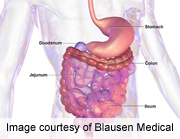- Double Mastectomy May Offer No Survival Benefit to Women With Breast Cancer
- Toxic Lead Found in Cinnamon Product, FDA Says
- Certain Abbott Blood Sugar Monitors May Give Incorrect Readings
- Athletes Can Expect High Ozone, Pollen Counts for Paris Olympics
- Fake Oxycontin Pills Widespread and Potentially Deadly: Report
- Shingles Vaccine Could Lower Dementia Risk
- Your Odds for Accidental Gun Death Rise Greatly in Certain States
- Kids From Poorer Families Less Likely to Survive Cancer
- Tough Workouts Won’t Trigger Cardiac Arrest in Folks With Long QT Syndrome
- At-Home Colon Cancer Test Can Save Lives
Researchers Uncover the Secret Behind Bowel Movements


Everybody does it, but until now researchers were unsure about the exact mechanisms behind a bowel movement.
New research reveals that two sets of so-called “pacemakers” work together to create a certain rhythm, and these pacemakers use nerves and muscles to allow two types of movement: one that allows the body to absorb nutrients and another that moves food along the digestive tract.
“In the long run, it’s simple,” Jan Huizinga, a gastroenterology scientist at the Farncombe Family Digestive Health Institute at McMaster University in Canada, said in a university news release.
“It’s like when a stone is dropped in water, it creates waves or motion that pushes things along, but when a second stone is dropped in the water, the movement changes to up and down, appearing to stay in the same place,” the researcher explained.
So, when people have diarrhea, this activity is too low. For those suffering from constipation, the same activity is too high, Huizinga and colleagues noted. Abnormal activity can also lead to pain associated with eating.
The study findings, published Feb. 24 in Nature Communications, could help scientists develop new drugs or nutrients to treat diarrhea, constipation, bloating or disorders that prevent people from absorbing nutrients properly.
More information
The U.S. National Institute of Diabetes and Digestive and Kidney Diseases has more about the digestive system and how it works.
Source: HealthDay
Copyright © 2024 HealthDay. All rights reserved.










